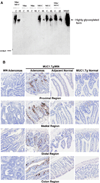Characterization of the MUC1.Tg/MIN transgenic mouse as a model for studying antigen-specific immunotherapy of adenomas
- PMID: 17707958
- PMCID: PMC2364598
- DOI: 10.1016/j.vaccine.2007.06.063
Characterization of the MUC1.Tg/MIN transgenic mouse as a model for studying antigen-specific immunotherapy of adenomas
Abstract
A bigenic MUC1.Tg/MIN mouse model was developed by crossing Apc/(MIN/+) (MIN) mice with human MUC1 transgenic mice to evaluate MUC1 antigen-specific immunotherapy of intestinal adenomas. The MUC1.Tg/MIN mice developed adenomas at a rate comparable to that of MIN mice and had similar levels of serum MUC1 antigen. A MUC1-based vaccine consisting of MHC class I-restricted MUC1 peptides, a MHC class II-restricted pan-helper peptide, unmethylated CpG oligodeoxynucleotide and GM-CSF caused flattening of adenomas and significantly reduced the number of large adenomas. Immunization was successful in generating a MUC1-directed immune response evidenced by increased MUC1 peptide-specific anti-tumor cytotoxicity and IFN-gamma secretion by lymphocytes.
Figures




Similar articles
-
MUC1-specific immune therapy generates a strong anti-tumor response in a MUC1-tolerant colon cancer model.Vaccine. 2007 Feb 19;25(9):1607-18. doi: 10.1016/j.vaccine.2006.11.007. Epub 2006 Nov 16. Vaccine. 2007. PMID: 17166639 Free PMC article.
-
Three different vaccines based on the 140-amino acid MUC1 peptide with seven tandemly repeated tumor-specific epitopes elicit distinct immune effector mechanisms in wild-type versus MUC1-transgenic mice with different potential for tumor rejection.J Immunol. 2001 Jun 1;166(11):6555-63. doi: 10.4049/jimmunol.166.11.6555. J Immunol. 2001. PMID: 11359807
-
Definition of MHC-restricted CTL epitopes from non-variable number of tandem repeat sequence of MUC1.Vaccine. 2000 Apr 3;18(19):2059-71. doi: 10.1016/s0264-410x(99)00515-0. Vaccine. 2000. PMID: 10706970
-
Tecemotide: an antigen-specific cancer immunotherapy.Hum Vaccin Immunother. 2014;10(11):3383-93. doi: 10.4161/hv.29836. Hum Vaccin Immunother. 2014. PMID: 25483673 Free PMC article. Review.
-
MUC1 and breast cancer.Curr Opin Mol Ther. 1999 Feb;1(1):98-103. Curr Opin Mol Ther. 1999. PMID: 11249691 Review.
Cited by
-
Colorectal cancer prevention: Immune modulation taking the stage.Biochim Biophys Acta Rev Cancer. 2018 Apr;1869(2):138-148. doi: 10.1016/j.bbcan.2017.12.002. Epub 2018 Jan 31. Biochim Biophys Acta Rev Cancer. 2018. PMID: 29391185 Free PMC article. Review.
-
C3-Liposome Delivery of MUC1 Peptide and TLR Agonists Enhances Adaptive Immunity and Results in Sex-Based Tumor Growth Differences.Pharmaceutics. 2025 Apr 3;17(4):468. doi: 10.3390/pharmaceutics17040468. Pharmaceutics. 2025. PMID: 40284463 Free PMC article.
-
MUC1: a multifaceted oncoprotein with a key role in cancer progression.Trends Mol Med. 2014 Jun;20(6):332-42. doi: 10.1016/j.molmed.2014.02.007. Epub 2014 Mar 22. Trends Mol Med. 2014. PMID: 24667139 Free PMC article. Review.
-
Microbe-Mucus Interface in the Pathogenesis of Colorectal Cancer.Cancers (Basel). 2021 Feb 4;13(4):616. doi: 10.3390/cancers13040616. Cancers (Basel). 2021. PMID: 33557139 Free PMC article. Review.
-
Genetically engineered mucin mouse models for inflammation and cancer.Cancer Metastasis Rev. 2015 Dec;34(4):593-609. doi: 10.1007/s10555-015-9549-1. Cancer Metastasis Rev. 2015. PMID: 25634251 Free PMC article. Review.
References
-
- Oshima M, Dinchuk JE, Kargman SL, Oshima H, Hancock B, Kwong E, et al. Suppression of intestinal polyposis in Apc delta716 knockout mice by inhibition of cyclooxygenase 2 (COX-2) Cell. 1996;87(5):803–809. - PubMed
-
- Eberhart CE, Coffey RJ, Radhika A, Giardiello FM, Ferrenbach S, DuBois RN. Up-regulation of cyclooxygenase 2 gene expression in human colorectal adenomas and adenocarcinomas. Gastroenterology. 1994;107(4):1183–1188. - PubMed
-
- Kargman SL, O'Neill GP, Vickers PJ, Evans JF, Mancini JA, Jothy S. Expression of prostaglandin G/H synthase-1 and -2 protein in human colon cancer. Cancer Res. 1995;55(12):2556–2559. - PubMed
-
- Sheehan KM, Sheahan K, O'Donoghue DP, MacSweeney F, Conroy RM, Fitzgerald DJ, et al. The relationship between cyclooxygenase-2 expression and colorectal cancer. Jama. 1999;282(13):1254–1257. - PubMed
Publication types
MeSH terms
Substances
Grants and funding
LinkOut - more resources
Full Text Sources
Molecular Biology Databases
Research Materials
Miscellaneous

